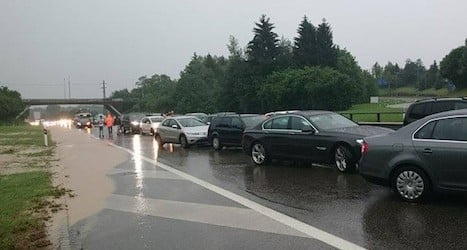The deluge began on Sunday and continued on Monday, putting roads and buildings under water, while cutting power in some locations.
A section of the A1 motorway was partially submerged in Will in the canton of Saint Gallen, where 150 emergency services staff responded to calls for help, the ATS news agency reported.
Close to 250 tonnes of gravel had to be removed from the road, a major artery that links the northeast part of the country to Geneva in the west, the agency said.
The gravel on the motorway reached a depth of up to 60 centimetres in places, according to the report.
Similar issues disrupted rail traffic in Saint Gallen and elsewhere in the canton of Thurgau, where police received 500 reports of damage and dozens of fire fighters worked around the clock in response.
In the Kradolf-Scönenberg region of Thurgau several streams spilled over their banks and flooded local roads.
Heavy rain also hit the cantons of Solothurn, Aargau and Basel-Country.
Rail traffic was disrupted on the line between Bern and Neuchâtel after flooding knocked out a section between Chiètres in the canton of Fribourg and Anet in the canton of Bern.
Shuttle buses were used to transport passengers until train service was restored on Monday at around 6pm, ATS said.
The H10 motorway was briefly closed in both directions between Champion and Anet due to high water in an underpass.
Elsewhere in the canton of Bern, basements, warehouses and underpasses were flooded in regions such as Schwarzenburgerland, ATS said.
Drinking water was polluted by bacteria in Zweisimmen, a municipality in the Obersimmental-Saanen district.
In the canton of Vaud, an 18-year-old man had to be transported to safety by a helicopter on Sunday after being caught on a rock in the Veveyse River , near Vevey, when the river rose rapidly, cantonal police said.
MetwoSwiss, the national weather office, forecast rain to continue across the country until Tuesday evening.
Relief is expected only on Wednesday when sunny periods are predicted in all regions.




 Please whitelist us to continue reading.
Please whitelist us to continue reading.
Member comments